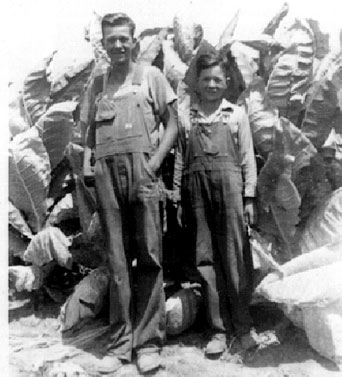| ||||||||||
Dr. Ronald P. Rogers CHIROPRACTOR Support for your body's natural healing capabilities 270-384-5554 Click here for details 


Columbia Gas Dept. GAS LEAK or GAS SMELL Contact Numbers 24 hrs/ 365 days 270-384-2006 or 9-1-1 Call before you dig Visit ColumbiaMagazine's Directory of Churches Addresses, times, phone numbers and more for churches in Adair County Find Great Stuff in ColumbiaMagazine's Classified Ads Antiques, Help Wanted, Autos, Real Estate, Legal Notices, More... 

|
C.B. and L.G. Wilson Farming In Adair Co., KY By: Col. Carlis B. Wilson Every farm in the area where we lived had this scene behind these brothers (see photo at end of story), some were on the owner's farm and others were share croppers. The farmers thought it was the most profitable crop that could be grown on those red banks of Adair county. While Adair County produced a good crop it was thought best to have "New Ground" in which to grow this burly. The clearing of the new ground was a lot of work. It usually involved felling of trees and cutting them up into logs or fire wood. Cleaning the ground of all debris such as small bushes by using a grubbing hoe and a axe. Once the brush and rocks was cleared from the field it was ready for plowing. A large beam type plow with a pointed plowshare and a cutting sword was used to brake the ground. This was no easy chore the ground was invested with stumps, roots and rocks which would hang the plow. The work mule was most desirable for the pulling of the plow, they could sense the plow getting hung in the undergrowth. Lessons were soon learned When the plants were set and given time to get established then the ground must be worked again to keep the weeds and grass from the plants after this was done about three times then the plants were ready for the young boys and girls to remove any worms that was on the plants, this could make one sick from the smell of the plants. After some time of growing the tops were taken off the plants so the leaves would spread and grow larger. Finally the time would come to cut and house the plants The graded plants were taken to a auction warehouse, this usually took place in late November or early December. What are the plants behind the Wilson Brothers? _Carlis B. WilsonThis story was posted on 2003-03-22 19:01:50
Printable: this page is now automatically formatted for printing.
Have comments or corrections for this story? Use our contact form and let us know. (AD) - Many Reunion organizing efforts are also advertised in our REUNIONS category in our CM Classifeds. These are posted at a very low cost. See RATES & TERMS
More articles from topic Local History:
Cooking On A Wood Stove The Short Hunters 1945 Plant Beds Of The 1940's 1931 Chevy On Hwy. 768, ca 1948 School Days in The Country, 1940s Wilson School, ca 1900 - 1953, Sparksville KY First Farm Tractor - 1947 Cornbread and Milk Russell Creek Dam Near Columbia, KY tobacco spitters View even more articles in topic Local History |


|
||||||||
|
| ||||||||||
|
Quick Links to Popular Features
Looking for a story or picture? Try our Photo Archive or our Stories Archive for all the information that's appeared on ColumbiaMagazine.com. | ||||||||||
|
Contact us: Columbia Magazine and columbiamagazine.com are published by Linda Waggener and Pen Waggener, PO Box 906, Columbia, KY 42728. Please use our contact page, or send questions about technical issues with this site to webmaster@columbiamagazine.com. All logos and trademarks used on this site are property of their respective owners. All comments remain the property and responsibility of their posters, all articles and photos remain the property of their creators, and all the rest is copyright 1995-Present by Columbia Magazine. Privacy policy: use of this site requires no sharing of information. Voluntarily shared information may be published and made available to the public on this site and/or stored electronically. Anonymous submissions will be subject to additional verification. Cookies are not required to use our site. However, if you have cookies enabled in your web browser, some of our advertisers may use cookies for interest-based advertising across multiple domains. For more information about third-party advertising, visit the NAI web privacy site.
| ||||||||||





















































